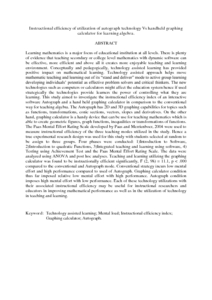Citation
Ahmad Tarmizi, Rohani and Mohd. Ayub, Ahmad Fauzi and Abu Bakar, Kamariah and Md. Yunus, Aida Suraya
(2008)
Instructional efficiency of utilization of autograph technology Vs handheld graphing calculator for learning algebra.
International Journal of Education and Information Technologies, 2 (3).
pp. 184-193.
ISSN 2074-1316
Abstract
Learning mathematics is a major focus of educational
institution at all levels. There is plenty of evidence that teaching secondary or college level mathematics with dynamic software can be effective, more efficient and above all it creates more enjoyable teaching and learning environment. Conceptually and pedagogically, technology assisted learning has provided positive impact on mathematical learning. Technology assisted approach helps move mathematic teaching and learning out of its “stand and deliver” mode to active group learning developing individuals’ potential as effective problem solvers and critical thinkers. The new technologies such as computers or calculators might affect the education system hence if
used strategically the technologies provide learners the power of controlling what they are learning. This study aimed to investigate the instructional efficiency index of an interactive software Autograph and a hand held graphing calculator in comparison to the conventional way for teaching algebra. The Autograph has 2D and 3D graphing capabilities for topics such as functions, transformations, conic sections, vectors, slopes and derivatives. On the other hand, graphing calculator is a handy device that can be use for teaching mathematics which is able to create geometric figures, graph functions, inequalities or transformations of functions. The Paas Mental Effort Rating Scale developed by Paas and Merrienboer, 2004 were used to measure instructional efficiency of the three teaching modes utilized in the study. Hence a true experimental
research design was used for this study with students selected at random to be assign to three groups. Four phases were conducted: 1)Introduction to Software, 2)Introduction to quadratic Functions, 3)Integrated
teaching and learning using software, 4) Testing using
Achievement Test and the Paas Mental Effort Rating Scale. The data were analyzed using ANOVA and post hoc analyses.
Teaching and learning utilizing the graphing calculator was found to be instructionally efficient significantly, F (2, 98) = 11.1, p < .000 compared to the conventional and Autograph mode. Conventional strategy incurs low mental effort and high performance compared to used of Autograph. Graphing calculator condition thus far imposed relative low mental effort with high performance. Autograph condition imposes high mental effort with low performance. Each of
these technology utilizations with their associated instructional efficiency may be useful for instructional researchers and educators in improving mathematical performance as well as in the utilization of technology in teaching and learning.
Download File
![[img]](http://psasir.upm.edu.my/15250/1.hassmallThumbnailVersion/Instructional%20efficiency%20of%20utilization%20of%20autograph%20technology%20Vs%20handheld%20graphing%20calculator%20for%20learning%20algebra.pdf)  Preview |
|
PDF (Abstract)
Instructional efficiency of utilization of autograph technology Vs handheld graphing calculator for learning algebra.pdf
Download (189kB)
| Preview
|
|
Additional Metadata
Actions (login required)
 |
View Item |

